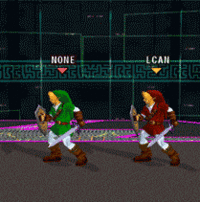L-canceling
L-canceling (an abbreviation of lag canceling or L button canceling, also called smooth landing on the official Super Smash Bros. website[1]) is a technique in Super Smash Bros. and Super Smash Bros. Melee that allows characters to act faster than usual when landing in the middle of an aerial attack. L-canceling is done by pressing a shield button 11 frames or fewer before landing during an aerial attack in Smash 64, or by pressing the shield button 7 frames or fewer before landing in Melee. The grab button also works because of its unique properties.
Only regular aerial attacks can be L-canceled; special moves that have landing lag cannot. If an attack is auto-canceled then L-canceling does not apply.
In Super Smash Bros.[edit]
Better known as Z-canceling as the Z button is the shield button, L-canceling in Smash 64 is performed by pressing the Z button 11 or fewer frames before landing. Doing so causes the character's regular landing animation to play instead of the air attack's landing animation, reducing their lag to 4 frames. Compared to lag intervals in the 20-30 range, this can allow incredible attack speed when combined with techniques such as double jump canceling with Yoshi and Ness, resulting in shield break combos.
In Super Smash Bros. Melee[edit]
L-canceling in Melee is performed by pressing L, R, or Z up to 7 frames before landing. Doing so causes the aerial attack's landing animation to play at double speed, cutting the lag time in half (rounded down). The L-cancel window can be considerably increased by pressing L, R or Z during hitlag, which also results in an L-cancel when the character lands up to 6 frames after the hitlag. While the L and R inputs can be either analog or digital, digital inputs also trigger a tech input.
L-canceling is a less effective technique than in the previous game because of the larger landing lag, which is further hindered by higher fall speeds and auto-cancel windows being less lenient across the board. While every character except Link could auto-cancel all of their aerials in a short hop in the previous game, only Ness, Luigi and Samus maintain the ability to auto-cancel all their aerials in a short hop and Peach and Zelda are the only newcomers who can auto-cancel all their aerials. Despite this, the decrease in lag is still significant enough to make L-canceled aerial attacks better than comparable ground attacks and it remains a vital technique in competitive play. This is especially true for characters with heavier aerial landing lag, most notably Bowser and Ganondorf.
In later games[edit]
L-canceling is not present in later games. Starting from Brawl, like wavedashing, Masahiro Sakurai felt that it made the gap between beginner players and advanced players too large[2]. The lack of L-canceling acts as an indirect nerf to characters that have aerial attacks with heavier landing lag and/or low jumps (most notably Ganondorf). To compensate for the removal of L-cancelling, many more aerials can be autocanceled in a short hop due to a combination of universally decreased falling speeds and more leninent autocancel windows. Every character in the game can autocancel at least one aerial in a short hop. Multiple characters benefit from having reduced landing lag on their aerials to partially compensate for the removal of L-canceling, with some examples including Peach, Kirby and Samus.
In Super Smash Bros. 4, however, equipment may have the Smooth Lander effect, which automatically provides a similar result. Depending on the number of times the effect is stacked, landing lag from aerials can be cut to 0.7x, 0.6x, or even 0.5x as in Melee. While some characters have had their aerials' landing lag reduced in the transition from Brawl (most notably Ganondorf), most other characters suffer from increased landing lag on their aerials. In addition to this, the autocancel windows of many aerials were also increased, making it harder to autocancel aerials in a short hop, and very few aerials have gained the ability to autocancel. Meta Knight is an example of a character adversely affected by both universal nerfs; he went from being able to autocancel all of his aerials in a short hop to only his up and down aerials, further exacerbated by the increased landing lag on all of his aerials. However, Meta Knight is not the only character affected by this.
In Ultimate, the landing lag of many aerial attacks has been further reduced from SSB4, lasting almost half as long overall and even rivaling or in some cases (such as with Young Link) surpassing their L-canceled variants from Melee, and many aerials (such as Falco's down aerial) have more leninent autocancel windows and decreased ending lag, enabling them to autocancel in a short hop unlike in SSB4. Despite this, some aerials still have more landing lag than their Melee L-canceled counterparts or even their Brawl counterparts (with Samus being a prominent example of this). The Landing Lag effect on some Support Spirits can also be used to reduce the landing lag of aerial attacks, similarly to the Smooth Lander equipment effect in SSB4.
Notes[edit]
- It is impossible to L-cancel Mr. Game & Watch's neutral, back, and up aerials due to using a nonstandard landing lag state (as they function as special moves, which cannot be L-canceled), similarly to how Ness' up and down smashes act unusually.
